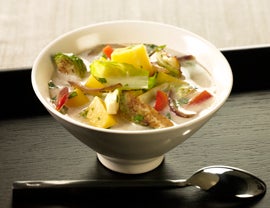Heading out the door? Read this article on the new Outside+ app available now on iOS devices for members! Download the app.

Most people get their first exposure to lemongrass in the form of Thai food (Tom Yum, anyone?), but there are many other ways to experience its amazing benefits—my favorite being the aroma.
In addition to its scrumptious culinary uses, lemongrass has some impressive healing and therapeutic qualities. Native to India and tropical Asia, lemongrass has been used for hundreds of years in Ayurvedic medicine for its antibacterial, digestive, diuretic, and muscle-relaxing properties. When cooked, lemongrass adds a delightful lemony flavor and aroma to the dish, not to mention antioxidants and B vitamins.
You can purchase lemongrass fresh or dried. The fresh stalks will keep in your refrigerator for a week or two, while the dried stalks will last a couple of years in a cool, dark place.

Three easy ways to use lemongrass
1. Make tea. Add fresh or dried lemongrass to hot tea for added flavor, aroma, and nutrition. Prepare fresh lemongrass by removing the outer layer, then slicing off the dry tops and hard bottoms. Using a rolling pin, pound the stalk to release the essential oils, then slice the stalk with a sharp knife and add it to your tea.
2. Add flavor to stir-fry and soup recipes. You don’t have to wait until your next visit to a Southeast Asian restaurant to enjoy lemongrass. Simply follow the preparation instructions above, and add lemongrass to your home-cooked meals.
Try Fall Foliage Lemongrass Soup (pictured above) or Lemongrass Curry with Broccoli and Tofu.
3. Use the oils on your body. Lemongrass oil is luxurious and mood-boosting. It is antibacterial and antiseptic, making it good for use on skin and scalp. Dab the oil on your skin, or mix it with other essential oils for a truly heavenly aroma.